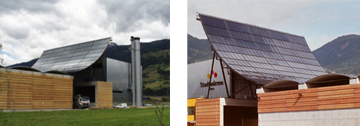

Solar Energy Technologies
Solar energy: free and delivered worldwide. The trick is converting it into a useful form. Energy Solutions advises clients on the state-of-the-art in solar energy systems.
Architectural Solutions
Solar has been used for heating buildings over millennia. Even caves facing the sun were preferred addresses. More recently, elegant ways of heating, cooling and lighting buildings using only architecture have been developed for nearly all regions of the world. Thoughtful building design is the first and most economical way to utilize solar energy.
Solar Electricity
By far the most common form of solar electricity is photovoltaics. The first solar cel was invented in the 1880's, though the technology really took off with first use in the US space program in 1958. By 1972, over 1000 satellites ran on solar. However, the cost of photovoltaic (PV) electricity was still 200 times greater than from standard power plants. The only economic uses were in remote installations. The early years of the 21st century saw enormous growth in PV, driven by the financial breakthrough of the feed-in-tariff (FIT) pioneered by Germany. FITs offer long-term contracts paying attractive rates for renewable power delivered to the grid. Along with tax credits and other forms of public subsidy, FITs are now used in many countries to encourage installation of PV. A commercial variant is the Power Purchase Agreement (PPA), where contracts may be on smaller scale.
There are a variety of PV technologies on the market. Most have huge environmental advantages over fossil fuel, with many having an "energy payback" (generating the energy used in making the PV module) of under two years. Main considerations for most applications may include aesthetics, roof structure, and of course the actual long-term cost of solar power. This involves many factors and is referred to as the Levelized Cost of Energy (LCOE).
Warantees of 25 years for PV panels are standard, which is impressive for any commercial product. Will the manufacturer actually be around for decades to back it up? PV panels can also vary substantially in quality, and even two products with an identical power rating may have significant differences in output. Other major components of the system also require care in selection. Quality in both components and engineering are key benefits of using carefully selected suppliers. Though many systems are hidden out of sight on rooftops, PV can also be an important part of a building's aesthetics.
With Building-Integrated Photovoltaics, PV panels are part of the building envelope. Standard or specialized systems have been used for roofing, facades, shading of windows, even as vertical or overhead glass. When PV replaces another material the offset cost can substantially improve economics. For instance, used in place of expensive materials such as polished stone siding or copper roofing, PV can sometimes pay for itself instantly, and all the energy is free.
Solar Heating and Cooling
Solar hot water is by far the largest use of solar energy worldwide. New capacity each year surpassed solar electric installations by nearly 10:1 until PV really took off after 2010. Though PV gets more attention, "traditional" solar panels are the right choice for many sites. Traditional flat plate solar panels dominate in some advanced markets, such as Austria and Germany, while in other regions evacuated tube systems are the norm. The most prominent example of this is China, the world's supplier of evacuated glass tubes. China often provides the tubes even for many systems where all other equipment is manufactured elsewhere.
Flat Plate solar collectors are simply an insulated box with glass on one side. Sun passes through and strikes an absorber that takes in the rays of the sun and heats up. Water (sometimes mixed with anti-freeze) moves through the absorber and into a storage tank.
Evacuated Tube systems are basically a vacuum-insulated test tube. The most common type uses the Sydney principle, which is open at the top and has one tube located inside another with the space between the two being a vacuum. The second most common is a single tube sealed at the top with a solar absorber located inside. These systems are generally more costly but more efficient and can have warrantees up to 20 years.
The most common passive systems use the thermosiphon principle, where a heat pipe or hot water rise into a tank located above the collector. These are common throughout the world in mild climates. Batch or Integral Collector Storage (ICS) systems combine the absorber and storage in one. They can vary from ungainly to quite attractive. Batch systems are usually the least costly hot water systems, and can even be made by do-it-yourselfers. Higher heat loss from the storage tank also makes these the least efficient solar hot water systems.Active solar systems use pumps to move the hot water to the storage tank, which can then be located remotely and allows for a more aesthetic system appearance. The hot water can be used for many purposes besides showering, from heating buildings to industrial process heat and district energy systems. The term "active solar" also applies to other powered designs such as fan-driven hot air panels or façade systems pre-heating ventilation air.




+1 207 329 2094
info@energyforbuildings.com
